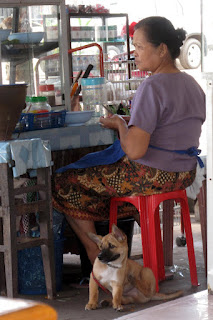 We are back in sleepy Vientiane after twenty-one days in Thailand and quite happy to be home. We had a great trip, no doubt, but there’s more to life than snorkeling and lounging on the beach, right?
We are back in sleepy Vientiane after twenty-one days in Thailand and quite happy to be home. We had a great trip, no doubt, but there’s more to life than snorkeling and lounging on the beach, right?Jen and I traveled by plane, bus, taxi, motorcycle taxi, van, car-ferry, speedboat, ferryboat, and most memorably, “longtail” boat. By the end of our trip, we had clambered on and off so many of these skinny, wobbly wooden boats that I elected to eschew an all-day boat tour on our last day in Krabi Province. Although it was by speedboat this time, I was pretty much “boated out” and chose to give my battered back a rest. Undeterred, Jen went by herself and visited the island (Ko Phi Phi Leh) where they filmed The Beach.
We spent a couple of more nights in big, bad Bangkok on the way back to Laos, principally to stock up on some consumer items not available in Vientiane. Bangkok is not exactly my cup of tea, I must confess. It is reminiscent of a tropical Mexico City: huge, hot, crowded, chaotic, and cursed by traffic that is, well, unbelievable. On our first journey to this metropolis, we were silly enough to arrive on the King’s birthday (for this gaffe, I take full responsibility). The taxi ride to our hotel was mercifully aborted after three hours of torturous gridlock when we finally just bailed on our arm-waving, teeth-sucking taxi driver into a massive throng of pink-shirted celebrators and hauled our bags the last couple of miles through the hot, sweaty, nighttime chaos. Talk about a tough traveling day!
A word about the aforementioned King Bhumibol (Rama IX) of Thailand . . . he is a superhero to his people and they love him with a fervor that is both overwhelming and, to us, endearing. His birthday (Dec. 5) is the biggest Thai holiday of the year and millions pour into the streets to celebrate. He has been King for sixty-four years and, at age 82, is now in precarious health. We discovered that he is a botanist, a sailor, a musician, a boat- designer, a photographer, an animal lover and much more. His image is everywhere in Thailand: on the wall of every home and business, on gigantic billboards and elaborate roadside displays celebrating his life and times. He is a sensitive looking man with thick, squarish eyeglasses that he has worn his whole life (we, of course, saw pictures of every phase of the King’s existence) and is a direct descendent of the character played by Yul Brynner in The King And I. I honestly think that what I will remember most about my trip to Thailand is the Thai people’s devotion to their King. When we finally arrived, disheveled and exhausted, at our hotel on the night of his birthday celebration, I wearily remarked to the girl behind the counter, “Wow, everyone really loves the King!”
Beaming, she answered sweetly, “I love, too!”























